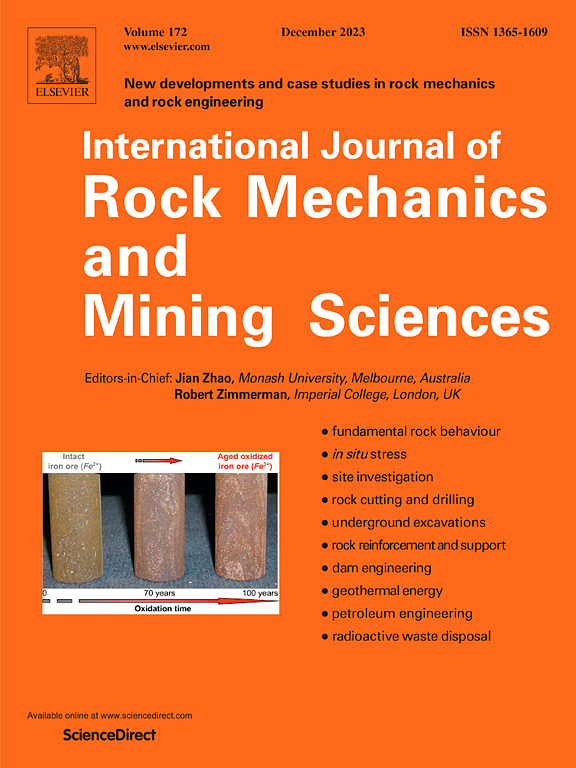天然气页岩的保水行为:润湿性控制的水饱和度和各向异性的水力学响应
IF 7
1区 工程技术
Q1 ENGINEERING, GEOLOGICAL
International Journal of Rock Mechanics and Mining Sciences
Pub Date : 2025-02-23
DOI:10.1016/j.ijrmms.2025.106061
引用次数: 0
摘要
页岩是一种细粒、富含有机物、超低渗透率的沉积地质物质,需要通过水力压裂进行采气。表征其保水行为对于预测流体力学行为和流体流动至关重要,但由于其复杂的孔隙网络和混合润湿性,仍然具有挑战性。本研究通过综合表征和实验室测试来研究气页岩的持水行为,在两个干湿循环中测量垂直和平行于层理平面的含水量和应变。结果表明,亲水性粘土矿物和疏水性有机物的共存限制了水进入部分孔隙和微裂缝网络,导致即使在零吸力下也不完全饱和。通过引入一个额外的参数来解释这种润湿性效应,对三个保水模型进行了修改,其中van Genuchten模型提供了最佳的整体拟合。拟合曲线显示了一个令人惊讶的低空气入口值,强调了渗透疏水网络在促进气体流动中的作用。膨胀应变表现为层理平行微裂纹的不可逆张开。收缩应变具有可逆性,较好地反映了弹性流体力学各向异性。与其他页岩的对比表明,收缩各向异性与埋深的相关性比与粘土含量的相关性更强,这表明压实作用和成岩作用可能比粘土含量起更重要的作用。润湿性可以降低孔隙和微裂纹对收缩各向异性的影响。这些发现强调了建立先进的页岩本构模型的必要性,这些本构模型将观察到的润湿性控制的含水饱和度和流体力学各向异性结合起来。本文章由计算机程序翻译,如有差异,请以英文原文为准。
Water retention behavior of a gas shale: Wettability-controlled water saturation and anisotropic hydromechanical response
Gas shales are fine-grained, organic-rich sedimentary geomaterials with ultra-low permeability requiring hydraulic stimulation for gas extraction. Characterizing their water retention behavior is critical for predicting hydromechanical behavior and fluid flow, yet it remains challenging due to their complex pore network and mixed wettability. This study investigates the water retention behavior of a gas shale through comprehensive characterization and laboratory tests, where water content and strains both perpendicular and parallel to the bedding plane were measured over two wetting-drying cycles. The results suggest that the coexistence of hydrophilic clay minerals and hydrophobic organic matter limits water access to parts of the pore and microcrack network, resulting in incomplete saturation even at a null suction. Three water retention models were modified by introducing an additional parameter to account for this wettability effect, among which the van Genuchten model provided the best overall fit. The fitted curves revealed a surprisingly low air entry value, underscoring the role of percolated hydrophobic networks in facilitating gas flow. The swelling strains indicated irreversible opening of bedding-parallel microcracks. The shrinkage strains were reversible, better representing the elastic hydromechanical anisotropy. Comparisons with other shales revealed that shrinkage anisotropy correlates more strongly with burial depth than with clay fraction, suggesting that compaction and diagenesis may play a more critical role than the amount of clay. Wettability may reduce the impact of pores and microcracks on shrinkage anisotropy. These findings emphasize the need for advanced constitutive models for gas shales that incorporate the observed wettability-controlled water saturation and hydromechanical anisotropy.
求助全文
通过发布文献求助,成功后即可免费获取论文全文。
去求助
来源期刊
CiteScore
14.00
自引率
5.60%
发文量
196
审稿时长
18 weeks
期刊介绍:
The International Journal of Rock Mechanics and Mining Sciences focuses on original research, new developments, site measurements, and case studies within the fields of rock mechanics and rock engineering. Serving as an international platform, it showcases high-quality papers addressing rock mechanics and the application of its principles and techniques in mining and civil engineering projects situated on or within rock masses. These projects encompass a wide range, including slopes, open-pit mines, quarries, shafts, tunnels, caverns, underground mines, metro systems, dams, hydro-electric stations, geothermal energy, petroleum engineering, and radioactive waste disposal. The journal welcomes submissions on various topics, with particular interest in theoretical advancements, analytical and numerical methods, rock testing, site investigation, and case studies.

 求助内容:
求助内容: 应助结果提醒方式:
应助结果提醒方式:


